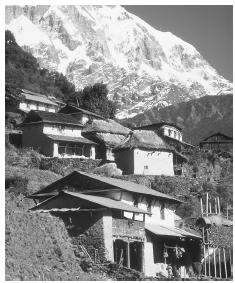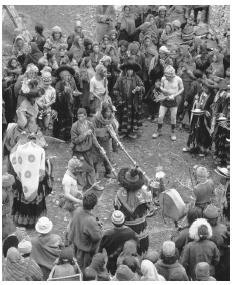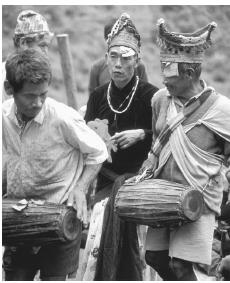Location and Geography. Nepal is a roughly rectangular country with an area of 147,181 square miles (381,200 square kilometers). To the south, west, and east it is bordered by Indian states; to the north lies Tibet. Nepal is home to the Himalayan Mountains, including Mount Everest. From the summit of Everest, the topography plunges to just above sea level at the Gangetic Plain on the southern border. This drop divides the country into three horizontal zones: the high mountains, the lush central hills, and the flat, arid Terai region in the south. Fast-moving, snow-fed rivers cut through the hills and mountains from north to south, carving deep valleys and steep ridges. The rugged topography has created numerous ecological niches to which different ethnic groups have adapted. Although trade has brought distinct ethnic groups into contact, the geography has created diversity in language and subsistence practices. The result is a country with over thirty-six ethnic groups and over fifty languages.
Demography. The population in 1997 was just over 22.6 million. Although infant mortality rates are extremely high, fertility rates are higher. High birth rates in rural areas have led to land shortages, forcing immigration to the Terai, where farmland is more plentiful, and to urban areas, where jobs are available. Migration into cities has led to over-crowding and pollution. The Kathmandu Valley has a population of approximately 700,000.
Linguistic Affiliation. After conquering much of the territory that constitutes modern Nepal, King Prithvi Narayan Shah (1743–1775) established Gorkhali (Nepali) as the national language. Nepali is an Indo-European language derived from Sanskrit with which it shares and most residents speak at least some Nepali, which is the medium of government, education, and most radio and television broadcasts. For many people Nepali is secondary to the language of their ethnic group or region. This situation puts certain groups at a disadvantage in terms of education and civil service positions. Since the institution of a multiparty democracy in 1990, linguistic issues have emerged as hotly debated topics.
Symbolism. The culture has many symbols from Hindu and Buddhist sources. Auspicious signs, including the ancient Hindu swastika and Shiva's trident, decorate buses, trucks, and walls. Other significant symbols are the emblems (tree, plow, sun) used to designate political parties.
Prominent among symbols for the nation as a whole are the national flower and bird, the rhododendron and danfe; the flag; the plumed crown worn by the kings; and the crossed kukhris
(curved knives) of the Gurkhas, mercenary regiments that have fought for the British Army in a number of wars. Images of the current monarch and the royal family are displayed in many homes and places of business. In nationalistic rhetoric the metaphor of a garden with many different kinds of flowers is used to symbolize national unity amid cultural diversity.
Ethnic Relations. The population consists of numerous racial, cultural, and linguistic groups that often are divided into three broad categories: Indo-Nepalese, Tibeto-Nepalese, and indigenous Nepalese. The Indo-Nepalese migrated from India over several

Hindu castes and Buddhist and animist ethnic groups were historically collapsed into a single caste hierarchy. At the top are high-caste Hindus. Below them are alcohol-drinking ( matwali ) castes, which include Mongolian ethnic groups. At the bottom are untouchable Hindu castes that have traditionally performed occupations considered defiling by higher castes. The Newars of the Kathmandu Valley have a caste system that has been absorbed into the national caste hierarchy.
Historically, members of the highest castes have owned the majority of land and enjoyed the greatest political and economic privileges. Members of lower castes have been excluded from political representation and economic opportunities. The untouchable castes were not permitted to own land, and their civil liberties were circumscribed by law. Caste discrimination is officially illegal but has not disappeared. In 1991, 80 percent of positions in the civil service, army, and police were occupied by members of the two highest castes.Nepal historically was one of the least urbanized countries in the world, but urbanization is accelerating, especially in the capital, and urban sprawl and pollution have become serious problems. Kathmandu and the neighboring cities of Patan and Bhaktapur are known for pagoda-style and shikhara temples, Buddhist stupas, palaces, and multistory brick houses with elaborately carved wooden door frames and screened windows. Although the largest and most famous buildings are well maintained, many smaller temples and older residential buildings are falling into disrepair.
Food in Daily Life. Many Nepalis do not feel that they have eaten a real meal unless it has included a sizable helping of rice. Most residents eat a large rice meal twice a day, usually at midmorning and in the early evening. Rice generally is served with dal, a lentil dish, and tarkari, achar, made of a fruit or vegetable. In poorer and higher-altitude areas, where rice is scarce, the staple is dhiro, a thick mush made of corn or millet. In areas where wheat is plentiful, rice may be supplemented by flat bread, roti. a cooked vegetable. Often, the meal includes a pickle Most families eat from individual plates while seated on the floor. Though some urbanites use Western utensils, it is more common to eat with the hands.

Conventions regarding eating and drinking are tied to caste. Orthodox high-caste Hindus are strictly vegetarian and do not drink alcohol. Other castes may drink alcohol and eat pork and even beef. Traditionally, caste rules also dictate who may eat with or accept food from whom. Members of the higher castes were particularly reluctant to eat food prepared by strangers. Consequently, eating out has not been a major part of the culture. However, caste rules are relaxing to suit the modern world, and the tourist economy is making restaurants a common feature of urban life.
Food Customs at Ceremonial Occasions. At weddings and other important life-cycle events, feasts are generally hosted by the families directly involved, and numerous guests are invited. At such occasions, it is customary to seat guests on woven grass mats on the ground outside one's home, often in lines separating castes and honoring people of high status. Food is served on leaf plates, which can be easily disposed of. These customs, however, like most others, vary by caste-ethnic groups, and are changing rapidly to suit modern tastes.
Basic Economy. The large majority of the people are subsistence farmers who grow rice, maize, millet, barley, wheat, and vegetables. At low altitudes, agriculture is the principal means of subsistence, while at higher altitudes agropastoralism prevails. Many households maintain chickens and goats. However, few families own more than a small number of cows, water buffalo, or yaks because the mountainous topography does not provide grazing land for large animals.
Nepal is one of the poorest countries in the world. This poverty can be attributed to scarce natural resources, a difficult terrain, landlocked geography, and a weak infrastructure but also to feudal land tenure systems, government corruption, and the ineffectiveness of development efforts. Foreign aid rarely goes to the neediest sectors of the population but is concentrate in urban areas, providing jobs for the urban middle class. The name of the national currency is rupee.
Land Tenure and Property. Historically, a handful of landlords held most agricultural land. Civil servants often were paid in land grants, governing their land on an absentee basis and collecting taxes from tenant-farming peasants. Since the 1950s, efforts have been made to protect the rights of tenants, but without the redistribution of land.
Overpopulation has exacerbated land shortages. Nearly every acre of arable land has been farmed intensively. Deforestation for wood and animal fodder has created serious erosion.
Commercial Activities. The majority of commercial activity takes place at small, family-owned shops or in the stalls of sidewalk vendors. With the exception of locally grown fruits and vegetables, many products are imported from India and, to a lesser extent, China and the West. Jute, sugar, cigarettes, beer, matches, shoes, chemicals, cement, and bricks are produced locally. Carpet and garment manufacturing has increased significantly, providing foreign exchange. Since the late 1950s, tourism has increased rapidly; trekking, mountaineering, white-water rafting, and canoeing have drawn tourists from the West and other parts of Asia. The tourism industry has sparked the commercial production of crafts and souvenirs and created a number of service positions, such as trekking guides and porters. Tourism also has fueled the black market, where drugs are sold and foreign currency is exchanged.
Major Industries. There was no industrial development until the middle of the twentieth century. Much of earliest industrial development was accomplished with the help of private entrepreneurs from India and foreign aid from the Soviet Union, China, and the West. Early development focused on the use of jute, sugar, and tea; modern industries include the manufacturing of brick, tile, and construction materials; paper making; grain processing; vegetable oil extraction; sugar refining; and the brewing of beer.
Trade. Nepal is heavily dependent on trade from India and China. The large majority of imported goods pass through India. Transportation of goods is limited by the terrain. Although roads connect many major commercial centers, in much of the country goods are transported by porters and pack animals. The few roads are difficult to maintain and subject to landslides and flooding. Railroads in the southern flatlands connect many Terai cities to commercial centers in India but do not extend into the hills. Nepal's export goods include carpets, clothing, leather goods, jute, and grain. Tourism is another primary export commodity. Imports include gold, machinery and equipment, petroleum products, and fertilizers.
Division of Labor. Historically, caste was loosely correlated with occupational specialization. Tailors, smiths, and cobblers were the lowest, untouchable castes, and priests and warriors were the two highest Hindu castes. However, the large majority of people are farmers, an occupation that is not caste-specific.
Kin Groups. Patrilineal kin groups form the nucleus of households, function as corporate units, and determine inheritance patterns. A man belongs permanently to the kinship group of his father, while a woman changes membership from her natal kin group to the kin group of her husband at the time of marriage. Because family connections are critical in providing access to political influence and economic opportunities, marriage alliances are planned carefully to expand kinship networks and strengthen social ties. Although women join the husband's household, they maintain emotional ties and contact with their families. If a woman is mistreated in her husband's household, she may escape to her father's house or receive support from her male kin. Consequently, women often prefer to marry men from the same villages.

Child Rearing and Education. Mothers are the primary providers of child care, but children also are cared for and socialized by older siblings, cousins, and grandparents. Often children as young as five or six mind younger children. Neighbors are entitled to cuddle, instruct, and discipline children, who are in turn expected to obey and defer to senior members of the family and community. Children address their elders by using the honorific form of Nepali, while adults speak to children using more familiar language. Because authority in households depends on seniority, the relative ages of siblings is important and children are often addressed by birth order.
Certain household rituals mark key stages in child's development, including the first taste of rice and the first haircut. When a girl reaches puberty, she goes through a period of seclusion in which she is prohibited from seeing male family members. Although she may receive special foods and is not expected to work, the experience is an acknowledgment of the pollution associated with female sexuality and reproductivity.
From an early age, children are expected to contribute labor to the household. The law entitles both girls and boys to schooling; however, if a family needs help at home or cannot spare the money for uniforms, books, and school fees, only the sons are sent to school. It is believed that education is wasted on girls, who will marry and take their wage-earning abilities to another household. Boys marry and stay at home, and their education is considered a wise investment.

No comments:
Post a Comment